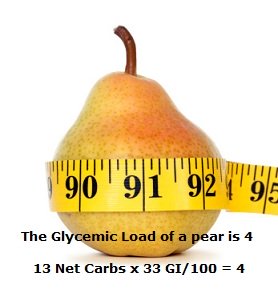The Glycemic Load Diet
All about the Glycemic Load index, sample of the Glycemic Load diet meal plan, low Glycemic Load foods
Glycemic Load vs. Glycemic Index
Some initial definitions to make this straightforward to understand. The Glycemic Index (GI) is a measure of the time taken to increase the level of glucose in our blood when eating food containing approx. 50g of carbohydrates.
This is a tough page to read and understand, but, it is very important you try and get it, as it's key to you losing weight.
The Glycemic Load (GL) was developed to show the impact of the food on our glucose level, i.e. how much will it increase by? The GL was seen by its creator as a more accurate measurement, after all, 50 grams of carbohydrates is a lot to consume, but we still want to know what the impact of eating a lesser amount of carbs is.
Understanding the impact food has on our blood sugar levels is important. The key to a balanced diet is to maintain steady blood sugar levels, we do not want to raise them otherwise we will feel hungry and eat more.
If you find that you are overweight, it’s possibly due to insulin resistance as your body finds it difficult to process all of the carbohydrates you are eating. To reduce this resistance, you simply have to reduce the Glycemic Load of your diet – well that’s the theory.
The Glycemic Load index was created by researchers at Harvard Medical School and is considered a better measurement by some, as it is takes into account both the Glycemic Index of foods and the portions of foods eaten.
An example so this is better understood. Think of beetroot which has medium GI of 64. But whilst it’s considered a medium GI food, we need to eat an awful lot of it as its carb content is very low. Its GL value is just 4, so why avoid it?
How to Calculate the Glycemic Load?
To calculate the Glycemic Load, multiply the amount of carbohydrates (in grams) in the specific food by its GI, and divide by 100.
GL = Quantity of Carbohydrate Content x GI / 100
 |
Example: |
The Glycemic Load Diet for Weight Loss
The Glycemic Load Diet was developed by Rob Thompson MD in 2006. He completed his fellowship in Cardiology from the University of Illinois in Chicago. This is not a calorie restricted diet, you can eat enough so you feel full, and you need to combine low GL foods (vegetables and fruit) with lean protein and a small amount of good fat.
Sample of Low Glycemic Load Diet:
Breakfast:
- 30 g Special K™ breakfast cereal (GL 11)
- 1/2 cup 2% milk (GL 2)
- 120g strawberries (GL 1)
Lunch:
- 3 oz. tuna steak (GL 0)
- 2 cups of lettuce with low carb vegetables (GL<5)
- ½ cup of vegetable soup (GL 11)
Snack:
- 50g mixed nuts and raisins (GL 3)
Dinner:
- 3 oz. grilled chicken (GL 0)
- 1 white baked potato with skin (150g) (GL 19)
- 1 cup sliced cooked carrots (GL 2)
- 1 medium apple raw (GL 6)
Total Daily Glycemic Load: < 60
Glycemic Load Chart
Low GL is 10 or less,Medium GL is 11-19,
High GL is 20 or greater
| Food Name | GI | Serving Size, grams | Carbs per Serving, grams | GL |
| Traditional French baguette bread | 57 | 30 | 18 | 10 |
| Banana, ripe | 51 | 120 | 25 | 13 |
| Carrots, raw | 16 | 80 | 8 | 1 |
| Carrots, peeled, boiled | 33 | 80 | 5 | 2 |
| Potato, white with skin, baked | 69 | 150 | 27 | 19 |
| Potato, white without skin, baked | 98 | 150 | 27 | 26 |
| Tagliatelle, egg pasta, boiled in water for 7 min | 46 | 180 | 44 | 20 |
| White rice, boiled | 43 | 150 | 38 | 16 |
| Cornflakes breakfast cereal | 74 | 30 | 25 | 19 |
| Honey | 74 | 25 | 21 | 16 |
Does The Glycemic Load Diet Work?
The GL diet claims that it will reduce the incidence of type 2 diabetes, reduce levels of bad cholesterol, lower blood pressure, improve digestion, fill you with energy and most importantly balance your glucose levels so you no longer feel hungry and you can lose weight.
The Glycemic Load has had a number of scientific studies. Back in 1997, the Harvard Medical School found that the group who had a diet in high GL foods with a low amount of cereal were more than twice as likely to develop diabetes than the group who had a diet high in cereal and in low GL foods.
In 2007, the American Journal of Clinical Nutrition carried out a study, but the sample size was only 36 so was inconclusive. However, for the small sample it showed that following a diet based on the Glycemic Load produced a greater weight loss than the other diets that were followed.
Dr Rob Thompson and Dana Carpender have written books containing both the Glycemic Load food list, and low Glycemic Load recipes, should you choose to follow this diet.
Author: Lana Soko
 |
 |
 |
Want to Learn More?
Like This Page?
|
Share This Page:
|
Search Our Site:

Free E-Book:
We Recommend:
Looking to get your body into great shape? Get the very best results for your efforts and money! Save your valuable time from surfing the internet. These are theBestselling Weight Loss Programs

Programs that work and have thousands of satisfied customers worldwide!
Fat Loss 4 Idiots

Imagine losing in just 11 days up to 9 pounds in weight. You’ll learn how to ensure your metabolism keeps going so your body loses more fat.

 |
